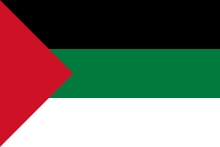This is an old revision of this page, as edited by Omar-toons (talk | contribs) at 02:21, 5 June 2014 (since someone doesn't agree on the adding of pres/royal standards... but prefers reverting everything instead of discussing it?). The present address (URL) is a permanent link to this revision, which may differ significantly from the current revision.
Revision as of 02:21, 5 June 2014 by Omar-toons (talk | contribs) (since someone doesn't agree on the adding of pres/royal standards... but prefers reverting everything instead of discussing it?)(diff) ← Previous revision | Latest revision (diff) | Newer revision → (diff)

The Pan-Arab colors are black, white, green and red. Individually, they have their origins in the flags of prominent empires and dynasties in Arab history. They are combined according to two sub-sets: the Arab Revolt colors, coming from the 1916 Arab Revolt flag, and the Arab Libertation colors, in which green is less significant.
Each of the four Pan-Arab colors were intended to represent a certain Arab dynasty, or era. The black was the color of the banner of Muhammad; white was used by the Umayyad Caliphate; green was used by the Fatimid Caliphate; and red was the flag held by the Khawarij.
The Arab Revolt colors are used currently in the flags of Jordan, Kuwait, Palestine, the SADR, and the United Arab Emirates. The Arab Liberation colors appear in the flags of Egypt, Iraq, Sudan, Syria, and Yemen. Formerly, Pan-Arab colors were shown in the flag of Libya as well as in flags of the short-lived United Arab Republic, Arab Federation and Federation of Arab Republics.
Current national flags with Pan-Arab colors
Sovereign states
Partially recognized states
Other flags with Pan-Arab colors
Former national flags
-

Hejaz (1917–1920) -
 Syria (1920-03-08 to 1920-07-24)
Syria (1920-03-08 to 1920-07-24) -

Hejaz (1920–1926) -

Emirate of Ha'il (1920-1921) -

Iraq (1921–1959) -

Hejaz (1926–1932) -

Syria (1932–1958 and 1961–1963) -

Palestine (1948-1959) -

Egypt (1952-1958) -

Arab Federation (1958) -

United Arab Republic (1958–1961) -

Iraq (1959–1963) -

North Yemen (1962–1990) -

Iraq (1963–1991) and Syria (1963–1972) -

South Yemen (1967–1990) -

Libya (1969–1972) -

Federation of Arab Republics (Egypt (1972–1984), Syria (1972–1980), and Libya (1972–1977)) -

Arab Islamic Republic (1974) -

Iraq (1991–2004) -

Iraq (2004-2008)
Flags used by political parties and paramilitary organisations
-

Flag of the Ba'ath Party, also used by Syrian Ba'ath Brigades -

Flag of the Syrian Interim Government, also used by the Free Syrian Army -

Flag used by Arab separatists and autonomists in Khuzestan, Iran -

Flag used by the separatist National Council of Ahwaz in Khuzestan, Iran
Former Arab flags
-

Rashidun Caliphate
(632–661) -

Umayyads
(661–750) -

Abbasids
(750–1258) -

Fatimids
(909–1171) -

Ayyubids
(1171–1341) -

Mamluk Sultanate
(1250–1517)
See also
References
- ^ Pan-Arab Colours, crwflags.com
- Abū Khaldūn Sati' al-Husri, The days of Maysalūn: A Page from the Modern History of the Arabs, Sidney Glauser Trans., (Washington D.C.: Middle East Institute, 1966), 46.
- Mahdi Abdul-Hadi, Palestine Facts: The Meaning of the Flag, passia.org
External links
- Pan-Arab colors
- Evolution of the Arab Flag, by Dr. Mahdi Abdul-Hadi (in Arabic)
| Flags of the Arab States | ||
|---|---|---|
 | ||








